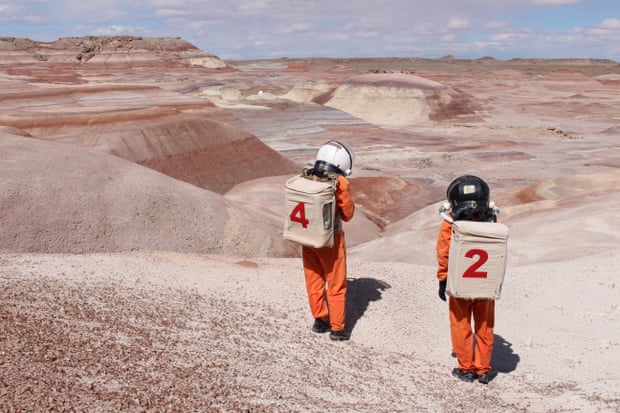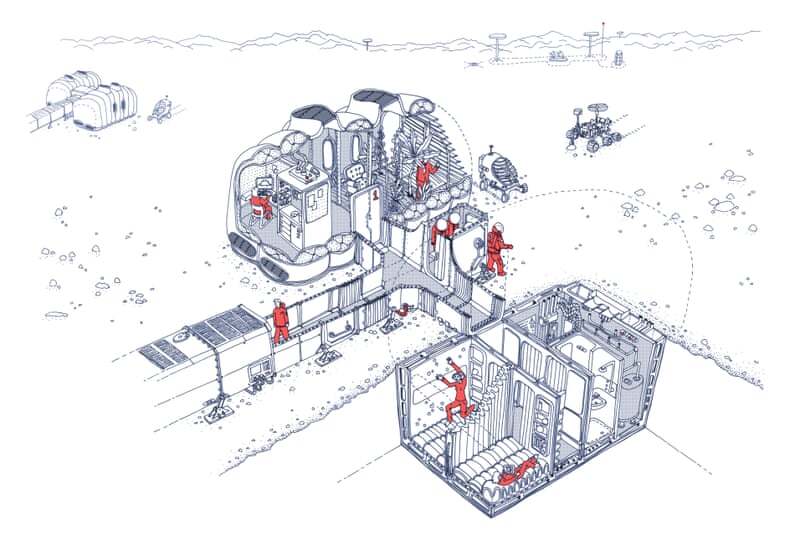Their two-level structure looks like a shiny gold bug – a woodlouse? a tardigrade? – perched on a shipping container. It stands small but conspicuous among the masts and rigging of heritage shipping, and the culture and retail buildings and preserved cranes of a former industrial zone. It represents one unit, designed for two astronauts, of an imaginary community that could be built on the planet, where 50 people might stay for months and more. The idea is to provide a “lens” on life on Earth, by exploring how to survive in a place of scarcity and danger.
There is an element of realism. The artists asked Hugh Broughton, an architect best known for designing Antarctic research stations, to design the structure, on the basis that he has worked in the most Mars-like places, in terms of environmental hostility, on Earth. Working with Owen Pearce, an architect formerly employed in his office, who has now set up a practice called Pearce+, Broughton has come up with techniques that, although untested, have some practical plausibility.
Good and Kent developed their ideas by visiting the Mars Desert Research Station in the Utah desert, which simulates missions to the planet, and by consulting a spacecraft systems engineer and an Earth and planetary scientist at the University of Bristol. Ultimately, their interest is less technical than human. What do you need to live well, they want to ask, in conditions of isolation? What would you have for breakfast? How would you cope with the fact that it takes up to 20 minutes for a message sent from Mars to reach Earth, and the same again for the reply to come back again? Or that you have to fix something yourself if it breaks, using whatever is available?
So they ran education workshops and will hold more inside their Martian house. Ultimately, say Good and Kent, they want to offer “a hopeful vision”. They want to show what is possible where high levels of resourcefulness are required, and how even in extreme circumstances it might be possible to think beyond mere survival. Whatever discoveries may arise are likely to be more relevant to an environmentally challenged Earth than the red planet, especially as participants in the workshops are unlikely ever to get to the latter.
The interior of the structure provides the backdrop for this work. As Broughton’s Antarctic projects are also concerned with wellbeing and mental health in challenging circumstances, he and Pearce can bring this expertise to bear on the Mars/Bristol endeavour. It comes with features designed to cheer up or at least distract its dwellers, and to put them in touch with nature: a window on to the dusty landscape (or, in this instance, office buildings and a cathedral tower); a double-layered roof light that contains some of the unit’s water supply in its thickness, such that it would freeze and unfreeze with the local weather conditions. (Mostly the former, given that the average temperature is minus 60C, the maximum 20C.) Hydroponically grown plants, helpful for survival and sanity, surround the putative astronauts.

At the same time you get a sense of the extremely limited dimensions available to space travellers. On the lower level, inside the shipping container, you see how tight are the sleeping quarters of such places. There was a concept in 1920s German architecture called existenzminimum, which described the least amount of space in which people could decently live; interplanetary travel takes this idea to a new level of tininess.
There’s part of me that would like this project to be a bit less speculative, that it would show more precisely what might be built on Mars if humans ever got to live there. The Nasa-backed Hi-Seas project in Hawaii has been pursuing this subject with substantial resources and expertise for a decade, as did the European, Russian and Chinese Mars500, from 2007 to 2011. A well-funded exploration of their findings would be quite something.
But, given that much is still unknown about the subject, there’s value in the glimpse on offer in Bristol. It also illustrates to an extreme degree a famous saying of William Morris. “Have nothing in your houses that you do not know to be useful or believe to be beautiful,” said the Victorian designer and sage. This would be true on Mars, with knobs on.
Building a Martian House is at M Shed, Bristol, from 17 August to 30 October. You can view the inside of the Martian House from 31 August; viewings are free but booking is required.
Quelle: The Guardian


